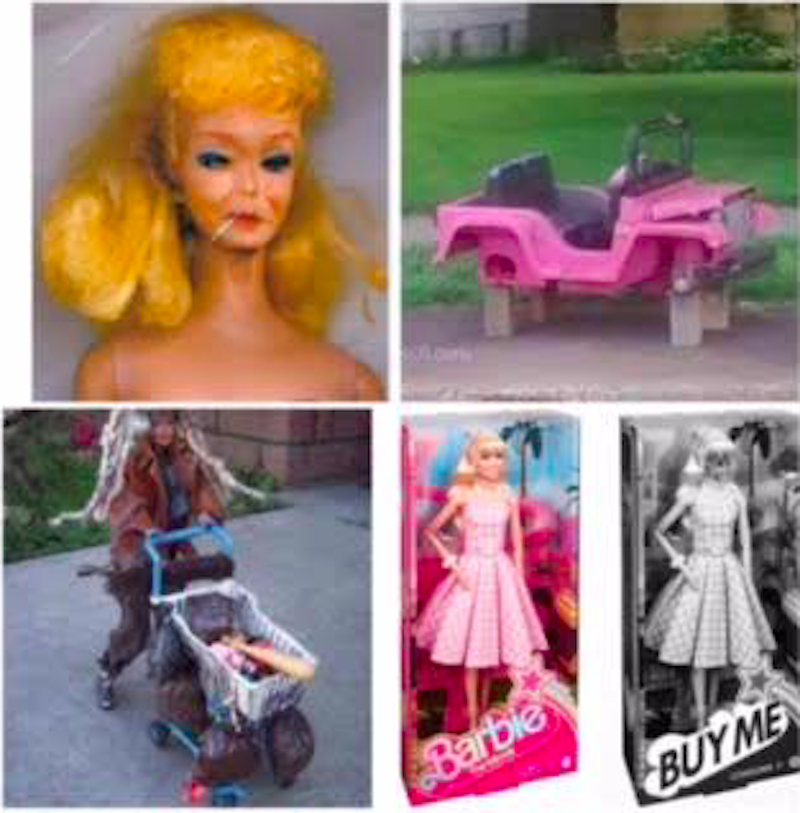The swinging 1960s. The groovy, happening decade of dramatic cultural change and rabid conspicuous consumption. Totally hip in all its Dr. Strangelove-style glory. The marvels of the modern age introduced a glut of disposable plastic products, color television, TV dinners, the space race, and total nuclear destruction. Just like today, only more crunchy. Before that, the mostly mindless, goofy gimmick toys of the gray, innocuous B&W 1950s. Simpleton toys like spinning tops, yo-yos, Slinky, hula-hoops, and Silly Putty ruled. Until the introduction of the Barbie doll. Every little girl wanted a Barbie for Christmas, and every little boy was jealous of the attention little girls received from them. It was a miraculous reinvention of the boring baby doll. The Raggedy Ann couldn’t top Barbie. There was no competition. Barbie had exploded into the marketplace.
When my little sister got her first Barbie in the early-1960s, I wondered what all the fuss was about. It wasn’t a new idea, as toys came and went, in and out of popularity. The gimmicks were the ever-changing fashions and accessories that went along with Barbie. The total package that the Mattel toy company had dreamed up. The ongoing advertising campaign for a new anatomically-correct doll, with endless product placement in marketing schemes geared toward young girls and mommy’s pocketbooks. A hard plastic pretty woman, minus nipples and vagina, to keep the fan base's customers wanting more. I’m generous when I say anatomically-correct, considering that in real-life measurements, Barbie’s feminine figure would be anorexic. Sporting silicone boobs and miniature feet, frozen with Demi Pointe contours, so the tiny shoes would go on and come off easily.
The interactive fashion doll that eventually had it all, complete with a dream house in Malibu and a pink convertible car, had no limit to the adventures she went on. Skiing in the Alps or tanning on the beach. The genius execs at Mattel thought she was getting lonely; of course she needed a friend besides herself. Introducing Ken, the boyfriend. This made it okay for little boys to play dress-up with a Ken doll while taking Barbie to dinner, dancing, or simulating sexual activity by banging the naked dolls together. Back then, boys who played with dolls were considered effeminate girly boys by macho men.
After that, like Adam and Eve and way before the new Barbie movie, Caucasian Ken and Barbie took on reality headfirst with fantasy scenarios of unlimited situations and additional new friends. It wasn’t until 1969 that Talking Christie, the first black friend of Barbie, made her debut. It would take another decade before the Mattel team released the first black and Hispanic dolls, also named Barbie. Meanwhile, around the same time, another company called Gizmo revealed Gay Bob to the public in 1977. The following year, they won an award for “most dubious achievement.” So much for advancing the culture for a millisecond.
Barbie originated as a German comic strip in a newspaper called Bild-Zeitung. The cartoon character was named Bild Lilli, a high-end call girl. Dolls were produced resembling her curvy figure and sexy long blonde hair. Men bought them as party gags, putting them on car dashboards like hula girls and giving them to girlfriends. In 1959, a woman named Ruth Handler and her kids, Barb and Ken, were touring Germany and saw the sexy Bild Lilli dolls everywhere. Ruth Handler, who was Jewish and also the wife of a Mattel toy CEO, took the concept of the famed German hooker and marketed it as a glamorous fashion doll, calling it Barbie, after her daughter’s nickname. Take that, you butcher, Klaus Barbie, Nazi pig!
Maybe that’s too outré, gauche, and gaudy. This writer and affiliates don’t endorse these statements. It’s a sick joke, much like the hideous Pepto-Bismol pink sauce globs on fast food Burger King whoppers to promote the new Barbie movie. Pink buns and all. Pink-glazed donuts, another marketing ploy promoted by Krispy Kreme. Dunkin’ dropped the name donuts but is still going all out pink for the Barbie Movie too. There’s even a drink made with vodka and pink lemonade called the Boozy Barbie. Pink popcorn in a Staten Island movie theater showing the Barbie movie. I predict it’s only a matter of time before pop singer Pink hops on the Barbie bandwagon with a song.
Enter Baltimore Barbie, the girl who had it all but lost it in the real-life lottery. Bad hair, garish makeup, a cigarette dangling from her herpes lips, hickeys, pimples, missing teeth, a pink eye, and a black eye, compliments of heroin-addled boyfriend Dundalk Ken. She’s the Barbiest Barbie of them all. There she goes now, pushing her shopping cart, filled with all her worldly possessions, fashion accessories, and accouterments. Happily singing the Pepto-Bismol jingle. That kinky doll is just a Barbie girl in a Barbie world, being the change she wishes to see in her make-believe world.

